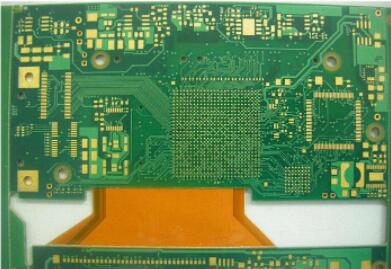Soft board classification
Flexible PCBs are usually classified as follows according to the number and structure of conductors:
1.1 Single-sided soft board
Single-sided flexible board, only one layer of conductor, the surface can be covered or not covered. The insulating base material used varies with the application of the product. Commonly used insulating materials include polyester, polyimide, polytetrafluoroethylene, and soft epoxy-glass cloth.
Single-sided flexible PCBs can be further divided into the following four categories:
1) Single side connection without covering layer
The wire pattern of this kind of flexible board is on the insulating base material, and the wire surface has no covering layer. Like the usual single-sided rigid PCB. This type of product is the cheapest one, usually used in non-critical and environmentally friendly applications. The interconnection is realized by soldering, welding or pressure welding. It is commonly used in early telephones.
2) One-sided connection with cover layer
Compared with the previous type, this type only has an extra layer of covering on the surface of the wire according to customer requirements. The pads need to be exposed when covering, and it can simply be left uncovered in the end area. If precision is required, the form of clearance hole can be adopted. It is the most widely used and widely used single-sided flexible PCB, and is widely used in automotive instruments and electronic instruments.

3) Double-sided connection without covering layer
This type of connection pad interface can be connected on the front and back of the wire. In order to achieve this, a via hole is opened on the insulating substrate at the pad. This via hole can be punched, etched or made by other mechanical methods at the required position of the insulating substrate. It is used for two-sided mounting of components, devices and occasions where soldering is required. There is no insulating substrate in the pad area of the via. Such pad area is usually removed by chemical methods.
4) With cover layer connected on both sides
The difference between this type and the previous type is that there is a covering layer on the surface. However, the cover layer has via holes, which allows termination on both sides and still maintain the cover layer. This kind of flexible PCB is made of two layers of insulating materials and a layer of metal conductors. It is used in the occasions where the covering layer and the surrounding devices need to be insulated from each other, and the ends need to be connected to both the front and back sides.
1.2 Double-sided FPC
Double-sided flexible board with two layers of conductors. The application and advantages of this type of double-sided FPC are the same as the single-sided FPC, and its main advantage is to increase the wiring density per unit area. It can be divided into with or without metallized holes and with or without covering layer: a without metallized holes, without covering layer; b without metallized holes, with covering layer; c with metallized holes, without covering layer ; D There are metallized holes and covering layers. The double-sided flexible PCB without covering layer is rarely used.
1.3 Multilayer FPC
Flexible multi-layer PCB, like rigid multi-layer PCB, adopts multi-layer lamination technology to make multi-layer flexible PCB. The simplest multilayer flexible PCB is a three-layer flexible PCB formed by covering two copper shielding layers on both sides of a single-sided PCB. This three-layer flexible PCB is equivalent to a coaxial wire or a shielded wire in electrical characteristics. The most commonly used multilayer flexible PCB structure is a four-layer structure, which uses metallized holes to realize interlayer interconnection. The middle two layers are generally the power layer and the ground layer.
The advantage of multilayer flexible PCB is that the base film is light in weight and has excellent electrical properties, such as low dielectric constant. The multi-layer flexible PCB board made of polyimide film as the base material is about 1/3 lighter than the rigid epoxy glass cloth multi-layer PCB board, but it loses the excellent single-sided and double-sided flexible PCB. Most of these products do not require flexibility.